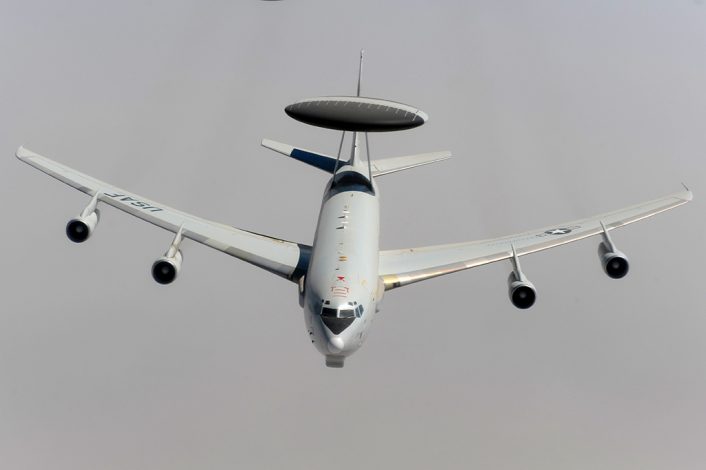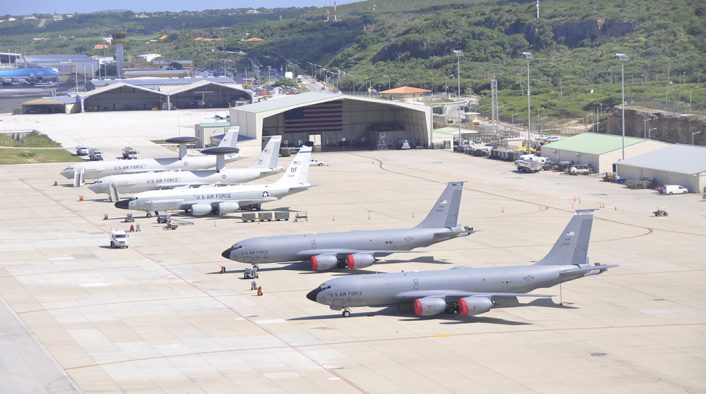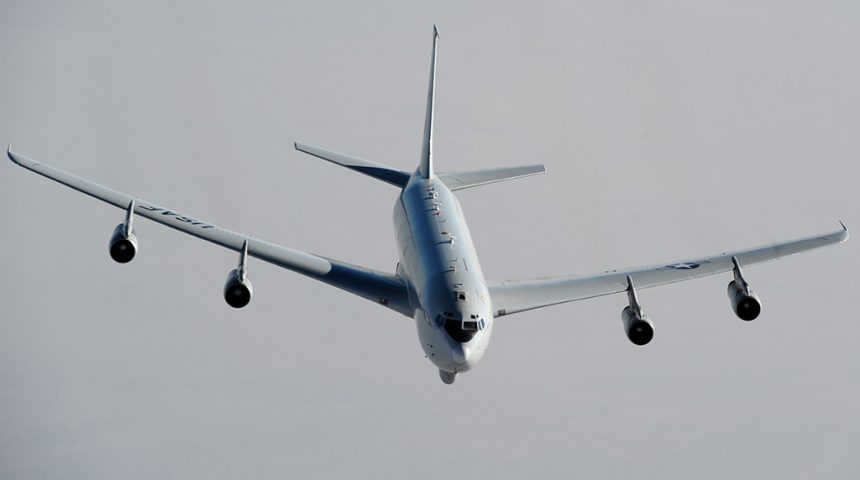The U.S. Air Force will temporarily deploy four aircraft and crews to Curaçao to support drug-interdiction operations.
An E-8 Joint STARS (JSTARS) and an E-3 Sentry Airborne Early Warning aircraft, supported by two KC-135 Stratotankers, will soon fly detection and monitoring missions in international airspace to support U.S. and international law enforcement authorities fightining criminal organizations trafficking illegal narcotics in the Caribbean region, the U.S. Southern Command has announced.
The aircraft will deploy to Curaçao, a Dutch Caribbean island located just 40 miles to the north of Venezuela. In particular, they will operate from the Curaçao-hosted Cooperative Security Location (CSL), also commonly referred to as a Forward Operating Location, in Willemstad.
U.S. Air Force has already conducted similar missions from both FOL Curacao and Aruba (another island, located 50 miles to the west of Curacao and just approximately 15 miles off Venezuela) in the past. Each FOL can host up to eight aircraft, depending on aircraft or airframe. While U.S. assets that can support counter-illicit-trafficking missions from the FOLs include the E-3 Sentry (AWACS), P-3C Orion, E-2 Hawkeye and the C-130 Hercules, RC-135 Rivet Joints have often been spotted there in the past. Anti-trafficking operations from the FOLs are carried out under under a counter narcotics partnership agreements with the governments of the island and the Kingdom of the Netherlands. In compliance with these agreements, the operations carried out at the FOLs are usully strictly limited to activities that detect and monitor illicit trafficking: in particular, AEW and MPA (Maritime Patrol Aircraft) identify and monitor aircraft supected of trafficking activities.

The E-3 Sentry AWACS is a sort of flying radar (and intelligence gathering aircraft thanks to its ESM – Electronic Support Measures – suite) that provides situational awareness and early warning of suspect aerial and maritime activity, command and control of an area of responsibility, battle management of theater forces, all-altitude and all-weather surveillance of the battle space, the E-8C Joint Surveillance Target Attack Radar System is a joint U.S. Air Force – Army program whose capabilities were described in a previous article we published here at The Aviationist:
The JSTARS is an airborne battle management, command and control, intelligence, surveillance and reconnaissance platform. It uses a multi-mode side looking radar to detect, track, and classify moving ground vehicles deep behind enemy lines. Its primary mission is to provide theater ground and air commanders with ground surveillance to support attack operations and targeting: through an antenna that can be tilted to either side of the aircraft to develop a 120-degree field of view, the JSTARS can cover nearly 19,305 square miles (50,000 square kilometers) and detect targets from a distance of 250 kilometers. Although the E-8C’s role is to build and update the picture of the battlefield, focusing on ground and moving targets, the the radar has also limited AEW-like capabilities: it can also detect helicopters, rotating antennas and low, slow-moving fixed wing aircraft even though these are partially hidden in the ground clutter. Surveillance data can be relayed in near-real time to the Army and Marine Corps common ground stations and to other ground command, control, communications, computers and intelligence, or C4I, nodes.
The E-8s regularly support the war against trafficking of illicit drugs in the U.S. Southern Command area of responsibility flying from Robins AFB, Georgia, home of the 461st Air Control Wing (ACW), the Air Force’s only Active Duty E-8C wing and the 116th Air Control Wing Georgia ANG.
For one week in August 2016, the Southern Command surged its anti-drug smuggling operations with bombers, KC-135 aerial refuelers, E-8 Joint STARS (Surveillance Target Attack Radar System) and E-3 Sentry AEW (Airborne Early Warning) aircraft that expanded their work supporting the United States Coast Guard and the JIATF-South (Joint Inter Agency Task Force South), the U.S. agency leading the fight against narco-traffickers.
As we reported back then, dubbed the “Big Week”, the operation saw also the involvement of B-1 Lancers and B-52 Stratofortresses that were assigned the difficult task of flying over large areas of the ocean in search of suspected trafficker boats acting as non-traditional Intelligence Surveillance and Reconnaissance (NTISR) platforms. The heavy bombers contributed to the surveillance mission sharing the data collected by the targeting systems and onboard sensors with multiple Naval-Coast Guard assets, something they usually don’t train too often.
The aircraft can also be tracked online during their long missions over the Caribbean, where they use their intelligence, surveillance and reconnaissance capabilities to scan wide swaths of ocean for suspicious vessels, operating alongside other aircraft, such as CBP or Navy P-3s.
4:53AM #USAF E-8 Joint Surveillance Target Attack Radar System #JSTARS takes off in North Carolina and heads south over the Caribbean for a counter narcotics mission.
8:27AM #USAF Boeing KC-135 Stratotanker military aerial refuelling aircraft takes off to top up the JSTARS pic.twitter.com/91TnW50gVP
— Simón Bolívar (@Simon85205764) April 7, 2020
#DRACO02 a #USNavy E-8 #JSTARS Joint Surveillance Target Attack Radar System flew another counter narcotics mission today for the Joint Inter Agency Task Force South against the Maduro regime’s Cartel of the Suns.#OperacionTunTun#JIATFS#Venezuela pic.twitter.com/mTArJBJzHp
— Simón Bolívar (@Simon85205764) April 18, 2020

President Donald Trump announced the “enhanced counter-narcotics operations” on Apr. 1, 2020. Since then, the U.S. has collaborated with international partners in more than a dozen Caribbean interdiction events. The deployment of ISR assets is just the latest measure to surge anti-drug trafficking ops in the region.
According to the U.S. Southern Command, to date, U.S. enhanced counter narcotics operations have resulted in the seizure of more than 49 metric tons of cocaine and almost 13,000 pounds of marijuana, an estimated loss of $1.2 billion to transnational criminal organizations. Law enforcement authorities have also detained more than 160 drug smugglers during the operations. Twenty-two countries support counter-narcotics efforts as part of Joint Interagency Task Force-South. Committed nations contributing to the international effort have been involved in 75 percent of drug interdictions this year.









